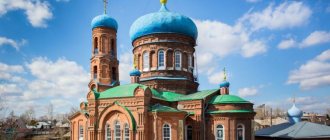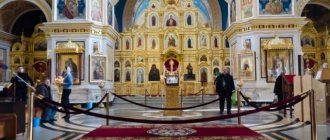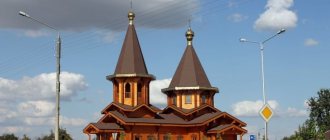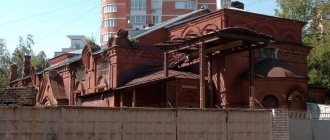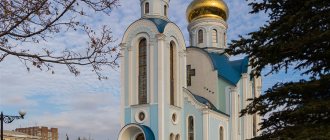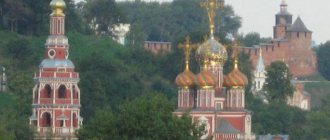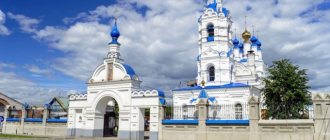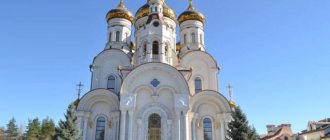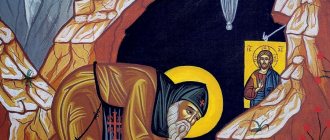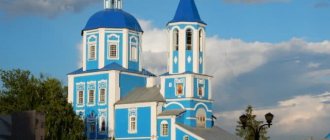| Volgograd Kazan Cathedral |
Volgograd and Kamyshin diocese
of the Volgograd Metropolis of the Russian Orthodox Church
- Diocesan administration: Russia, 400012, Volgograd, st. Chapaeva, 26
- Tel., 36-86-06
- Official site:
- Canonical territory: Volgograd, Volzhsky and Kamyshinsky GO; Gorodishchensky, Dubovsky, Kamyshinsky, Kotovsky districts of the Volgograd region.
- Cathedrals: Alexander Nevsky and Kazansky in Volgograd, Nikolsky in Kamyshin
- On the map: Yandex.Map, Google map
Since 1261, the lands of the modern Volgograd region belonged to the Sarai diocese, from 1555 to the Kazan diocese, and from 1606 to the Astrakhan diocese.
In 1799, local parishes became part of the newly established Saratov diocese, which in 1803 was transformed into the Penza diocese. In 1828-1918 - again under the jurisdiction of the Saratov department. The Tsaritsyn diocese was created in 1918. According to some sources, at first it was a vicariate of Saratov, but later became independent. The diocese ceased to exist in the second half of the 1930s.
In the 1920-30s there was a Stalingrad renovationist diocese.
On July 8, 1943, the Stalingrad diocese (within the Stalingrad region) was entrusted to the Saratov bishop for parallel management of both departments.
From June 26, 1944 to July 15, 1959, the Stalingrad region was part of the Astrakhan diocese, after which it was transferred to the Saratov diocese.
On January 31, 1991, it was revived as an independent diocese, having been separated from Saratov. The boundaries of the diocese were determined along the boundaries of the Volgograd region.
On March 15, 2012, the independent Uryupinsk and Kalachevsk dioceses were separated from the Volgograd diocese, after which the Gorodishchensky, Dubovsky, Kamyshinsky and Kotovsky districts, as well as the Volgograd, Volzhsky and Kamyshinsky urban districts in the middle part of the Volgograd region remained under the jurisdiction of the Volgograd department. At the same time, the Volgograd See became the center of the newly established Volgograd Metropolis.
Historical names
- Tsaritsynskaya (1918 - 1925)
- Stalingrad (1925 - ?)
- Volgogradskaya (since 1961)
- Volgogradskaya and Kamyshinskaya (since January 31, 1991)
Statistics
- 1944 - 16 churches and houses of worship in the Stalingrad region.
- 1945 - 25 operating churches and houses of worship in the Stalingrad region.
- 1947 - 42 operating churches and houses of worship in the Stalingrad region.
- January 31, 1991, at the time of re-establishment - 43 parishes, 72 clergy [1]
- 2003 - 190 churches, 6 monasteries [2]
- January 1, 2011 - 303 active parishes (of which 73 are in Volgograd, 18 are prison); 286 clergy (of which 262 presbyters, 24 deacons); 9 monasteries; in the monasteries there are 26 robed monks, 63 robed nuns, 6 monks, 14 nuns [3]
- October 1, 2012 - 2 monasteries; 15 robed monks, 22 robed nuns, 4 nuns; 126 operating parishes (of which 75 are in Volgograd), incl. 10 prison (of which 6 are in Volgograd); 137 clergy, incl. in the rank of priest - 121 (1 archimandrite, 5 abbots, 10 hieromonks, 41 archpriests, 64 priests), 16 deacons (3 protodeacons, 9 deacons, 4 hierodeacons) [4]
- November 20, 2013 - 2 monasteries; 12 robed monks, 22 robed nuns, 4 nuns; 130 operating parishes (of which 78 are in Volgograd), including 10 prison parishes (of which 6 are in Volgograd); 139 clergy, incl. in the rank of priest - 120 (1 archimandrite, 6 abbots, 11 hieromonks, 35 archpriests, 67 priests), 19 people. in the diaconate (4 protodeacons, 12 deacons, 3 hierodeacons) [4]
Archpastors
- Damian (Govorov) (1918 - 1920)
- Nifont (Fomin) (? - 1922)
- Tikhon (Rusinov) (July 4, 1924 - December 22, 1925) high school, bishop. Ust-Medveditsky
- Anthony (Romanovsky) (December 8, 1935 - January 15, 1937) v/u, bishop. Stavropol
- Grigory (Chukov) (July 8, 1943 - May 26, 1944) v/u, archbishop. Saratovsky
| Volgograd Metropolis |
Russian Orthodox Church
Part of the Volgograd Metropolis
Since 1261, the lands of the modern Volgograd region were part of the Sarsk diocese, and since 1555 they belonged to the Kazan diocese. In 1602, shortly after the founding of the Tsaritsyn fortress, the Astrakhan diocese was created, to which, from 1606, all the churches “along the Volga, starting from Saratov to the south, along the Medveditsa and Khopru to the Don” were assigned. In 1799-1918. local parishes were part of the Saratov diocese, which was called in 1803-1828. Penza-Saratov, and from November 3, 1828 - Saratov and Tsaritsyn.
A separate Tsaritsyn diocese was created in 1918, and since 1925 - the Stalingrad diocese. On July 15, 1959, the parishes of the diocese were included in the Saratov diocese. The newly established diocese was called Saratov and Stalingrad (after the renaming of Stalingrad in 1961 - Saratov and Volgograd). On January 31, 1991, an independent diocese, the borders of which coincide with the borders of the Volgograd region, was renewed as Volgograd and Kamyshin.
Cathedral city - Volgograd.
By the decision of the Holy Synod of March 15, 2012 (magazine No. 4), the Kalachevsk and Uryupinsk dioceses were separated from the diocese. The Volgograd diocese is included in the Volgograd Metropolis.
Diocese today (as of January 2022)
Deaneries and deaneries
- Alexandrovskoe - Archpriest Igor Malov
- Beketovskoe - Archpriest Alexy Zimovets
- Volgograd - Archpriest Anatoly Bezborodov
- Gorodishchenskoye - priest Alexy Sukhanov
- Dubovskoye - Archpriest Sergiy Ermakov
- Elshanskoe - Archpriest Nikolai Babak
- Zatsaritsynskoe - Archpriest Vladislav Sidorenko
- Kamyshinskoe - Archpriest Anatoly Karpets
- Sareptskoe - Archpriest Sergius Tyupin
- Northern - Priest Dionysius Prozorov
- Stalingrad - priest Oleg Ivashchenko
Monasteries
- Holy Spirits Men's 400012, Volgograd, st. Chapaeva, 26; tel.; e-mail and.o. rector - Hieromonk Prokhor (Kuksenko)
- Voznesensky female 404002, Volgograd region, Dubovka; tel. +7 969 658-39-97; e-mail abbess - abbess Anna (Erofeeva)
The total number of active parishes is 119.
Number of clergy and religious
The number of full-time clergy is 143, including:
- in the priesthood - 125,
- in the diaconate - 18.
The number of monastics is 43, including:
- in the priesthood - 16,
- in the diaconate - 3,
- without holy orders - 24.
Social institutions
- department for church charity and social service 400120, Volgograd, st. Cherepovetskaya, 92/2; tel. (8442) 95-35-53; e-mail director - priest Evgeny Kataev
- House for large families with adopted children "Boriso-Glebskoe Children's Village" 400012, Volgograd, Avenue named after. Marshala Zhukova, 77; tel. (8442) 54-14-52 property manager - Natalya Petrovna Brigadirenko
- Collection and distribution point for clothing aid at the diocesan department for church charity 400120, Volgograd, st. Cherepovetskaya, 92/2; tel. (8442) 95-35-53 responsible - Borisova Galina Nikolaevna
- Sisterhood in the name of the Holy Martyrs Grand Duchess Elizabeth and Nun Varvara at the Church of Blessed Xenia of Petersburg 400011, Volgograd, st. Krivorozhskaya, 2A; tel. +7 902 650-01-07 elder sister - Lyudmila Vasilievna Malyutina; confessor - Hieromonk Nikolai (Drannikov)
- Sisterhood in the name of the martyr Natalia at the temple in honor of the icon of the Mother of God “Unexpected Joy” 400065, Volgograd, st. Opolchenskaya, 40, bldg. 2; tel. +7 older sister - Natalya Aleksandrovna Ovsyanina; confessor - Archpriest Anthony Trostnikov
Diocesan media
- “Orthodox Tsaritsyn” (monthly magazine)
- official website of the Volgograd diocese https://volgeparhia.ru/
official pages of the diocese on social networks:
- VKontakte - https://vk.com/volgeparhia_ru
- YouTube - https://www.youtube.com/channel/UC7wWyP4E39mxHnz98vqD8Xw
- Facebook - https://www.facebook.com/volgeparhia
- Instagram —https://www.instagram.com/volgeparhia/
deanery websites:
- Alexandrovskoe – central-blag.ru/
- Beketovskoe – paraskeva-vlg.ru/
- Volgogradskoe - dzerzh.blagochin.ru/
- Gorodihe.blagochin.ru/
- Dubovskoe - dubovskoe.blagochin.ru/
- Elshanskoye - sovetskoe.blagochin.ru/
- Zatsaritsynskoye - voroshblagochin.cerkov.ru/
- Kamyshinskoye - blagozinie.cerkov.ru/
- Sareptskoye - krasnoarmeysk.blagochin.ru/
- Northern - traktor.blagochin.ru/
- Stalingrad - kroktyabr.blagochin.ru/
Educational establishments
- Center for training church specialists of the Volgograd diocese 400012, Volgograd, st. Chapaeva, 26; tel.; e-mail director - priest Vyacheslav Patrin
- Tsaritsyn Orthodox College 400012, Volgograd, st. Chapaeva, 26; tel. +7 917 331-41-14; e-mail director - abbot Christopher (Kazantsev)
- Center for Family Education "Russian Classical School" 400012, Volgograd, st. Chapaeva, 26; tel. +7 961 657-04-28; e-mail manager - Evgeniy Gennadievich Kovalev
The Tsaritsyn diocese appeared in 1918, it was headed by Bishop Damian
During the years of the revolution, approximately six hundred parishes operated on the territory of the modern diocese. In order to centralize administration at the regional level, Patriarch Tikhon created the Tsaritsyn diocese, at the head of which he placed Bishop Damian (Govorov) of Petrovsky.
Bishop Diaman (Govorov) - the first head of the Tsaritsyn diocese
This Orthodox figure was born on February 11, 1855. The father was a priest, so his son naturally received a spiritual education and began to serve in Crimea, then moved to Kyiv, and then to Chisinau. In the summer of 1917, Father Damian was appointed vicar of the Saratov region, and in 1918 he was called to head the Tsaritsyn diocese.
But already in 1919 - 1920, Bishop Damian, as a supporter of the white movement, was forced to leave the country. In Europe, he achieved the rank of archbishop for his services to the Church and died in 1936.
In the Volgograd diocese there is a miraculous icon of the Mother of God and holy springs
Orthodox Volgograd has its own shrines. One of the most revered is the miraculous Uryupinsk Icon of the Mother of God. It is kept in the Uryupinsk Church in honor of the Intercession of the Blessed Virgin Mary.
This icon was discovered on June 8, 1827, after which the ascetic Irina Lazareva kept it in her cell. According to her testimony, the icon immediately healed her friend, who had been ill for almost a quarter of a century, from an illness.
The miraculous Uryupinsk Icon of the Mother of God
Subsequently, many people dreamed of the icon, and these people also received healing.
As a result, in 1854, the icon was moved to its current location, where it continued to save people from terrible diseases.
According to legend, there was a healing spring where the icon was found. The Bolsheviks tried to bury him, but they failed.
Source of the Uryupinsk Icon of the Mother of God
There are other especially revered sources in the Volgograd diocese:
- Apostle John the Theologian;
- Great Martyr Paraskeva Friday;
- Kazan Icon of the Mother of God;
- Archangel Michael;
- Saint John the Baptist.
The Soviet government tried to destroy the diocese - directly and with the help of Hieromonk Iliodor
Soviet power hit the Tsaritsyn diocese hard. Atheists destroyed monasteries and closed two large religious schools:
- Kamyshenskoe;
- Ust-Medveditskoye.
Another blow was dealt by Hieromonk Iliodor, an extraordinary personality in the history of our country. He was a radical man, a hater of Jews and intellectuals. This monk had oratorical abilities and always went against the higher clergy. But Iliodor was not afraid of anything, since he was supported by Grigory Rasputin.
Hieromonk Iliodor was banned from serving and ordered to be arrested, but all this did not produce results. The monk was not even afraid of his patron, Rasputin.
Hieromonk Iliodor, who was banned from serving, made a lot of efforts to harm the Tsaritsyn diocese
This narcissistic man willingly gave interviews and tried to remain visible, as he knew how to convince the masses. In 1918, fate once again brought Iliodor to Tsaritsyn, where he organized the “Eternal Peace” sect.
With the support of the atheistic authorities, Iliodor confused the people and tried to proclaim himself the patriarch of the country, but he did not achieve success and in 1922 he fled abroad, however, from there he continued to plot the machinations of the Russian Orthodox Church. He died in 1952.
Current state
In the winter of 1991, the Holy Synod allocated a separate Volgograd diocese, headed by Bishop German (Timofeev). Volgograd remained the cathedral city, and Kazan (Volgograd) and Nikolsky (Kamyshin) cathedrals became cathedrals.
When the territorial unit was restored, 18 parishes and 5 monasteries immediately opened, but their growth was so rapid that after 11 years, in 2012, the Synod decided to create the Volgograd Metropolis for greater efficiency of regional administration and divide it into several parts:
- Volgogradskaya;
- Kalachevskaya;
- Uryupinskaya;
- Kamyshinskaya;
- Pallasovskaya;
- Novoanninskaya.
Service of Volgograd Metropolitan Theodore in the Kazan Cathedral
After the division, only about 20 parishes remained in the Volgograd diocese and they are led by Bishop Theodore (Cazanov), who also heads the metropolis of the same name.
News and other information are published on the official website of the Volgograd diocese
The Volgograd diocese has an official website. There you can find interviews and sermons of the highest clergy of the entire metropolis, a schedule of services and much more.
Official website of the Volgograd diocese
Those wishing to receive spiritual education can find information about local religious institutions on the website.
The site administration regularly publishes Orthodox news: important events in the life of the diocese, holidays, festivals. For the convenience of users, all information is divided into topics. Those interested can read the news from the youth department, news on the canonization of saints, or something else.
To establish feedback from visitors, new competitions on Orthodox themes are regularly held.
By leaving a comment, you accept the user agreement
Both monasteries of the Volgograd diocese were closed for almost the entire 20th century
There are two old monasteries on the territory of the Volgograd diocese:
- Holy Ascension Dubovsky Monastery. Women's monastery. It was founded in 1871 in the vicinity of Tsaritsyn using donations. It accommodated almost three hundred people, but after the revolution the monastery was closed. The temples there were destroyed. Only in 1991 the activity of the monastery was resumed.
Holy Ascension Dubovsky Monastery (Dubovka)
- Volgograd Monastery in honor of the Descent of the Holy Spirit on the Apostles. Initially, in 1908, a bishop's courtyard was formed here. And in 1912 this place was converted into a monastery. It is notorious for the fact that Hieromonk Iliodor preached here. In 1913, the monastery was converted into a women's monastery, and in 1923 it was closed. The Soviet government took away the buildings for its own needs. In 1992, the monastery was revived. Now he is male again.
Volgograd Monastery in honor of the Descent of the Holy Spirit on the Apostles
The Saints
The Volgograd region suffered extremely from the repressions of the new socialist government - many priests were arrested and subsequently killed. Two of them are especially revered by Orthodoxy, since they were canonized as saints - these are the martyrs Yakov (Jacob) Gorokhov and Nikolai Popov.
Archpriest Yakov Gorokhov (1879-1921)
Yakov Gorokhov was born in 1880 into a family of missionaries and became a deeply spiritual man. Yakov followed in the footsteps of his father and began to serve sick soldiers in Tsaritsyn, and also collected donations for them. He spoke negatively about the revolution and remained a supporter of the monarchy to the end.
In 1917, Yakov became dean of Tsaritsyn and conducted services in several churches, since there were not enough priests due to constant arrests. He was arrested in May 1921 for supporting whites and was shot on the 31st.
Nikolai Popov was also born in 1864 into a religious family, became a priest and actively preached Orthodoxy. He dealt with issues of spiritual education and improvement of churches, served as a priest on the Verkhne-Gnutov farm, served people and tried to meet their needs. His uncle served in the white army, and the priest actively communicated and spiritually instructed the Cossacks. When the Bolsheviks established their power in 1919, he was immediately arrested.
While imprisoned, he actively supported the prisoners and even visited his flock with an escort. However, in the summer of 1919 he was hacked to death with a saber, like the other 200 prisoners. Believers from the Verkhne-Gnutovo farm took the body of their shepherd and buried it with honors behind the church where he served.
